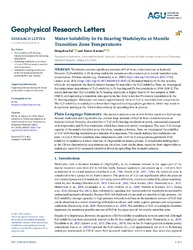Water Solubility in Fe‐Bearing Wadsleyite at Mantle Transition Zone Temperatures
DOI: https://doi.org/10.1029/2021GL092836
Persistent URL: http://resolver.sub.uni-goettingen.de/purl?gldocs-11858/9546
Persistent URL: http://resolver.sub.uni-goettingen.de/purl?gldocs-11858/9546
Fei, Hongzhan; Katsura, Tomoo, 2021: Water Solubility in Fe‐Bearing Wadsleyite at Mantle Transition Zone Temperatures. In: Geophysical Research Letters, Band 48, 9, DOI: 10.1029/2021GL092836.
 |
Dokument öffnen: |
Wadsleyite can store significant amounts of H2O in its crystal structure as hydroxyl. However, H2O solubility in Fe‐bearing wadsleyite remains poorly constrained at mantle transition zone temperatures. Previous studies (e.g., Demouchy et al., 2005 [https://doi.org/10.2138/am.2005.1751]; Litasov et al., 2011 [https://doi.org/10.1007/s00269-010-0382-3]) focused primarily on Fe‐free systems, which do not represent the Earth's interior because Fe may affect the H2O solubility. Here, we investigated the temperature dependence of H2O solubility in Fe‐bearing and Fe‐free wadsleyite at 1500–2100 K. The results indicate that H2O solubility in Fe‐bearing wadsleyite is higher than in Fe‐free samples at 1800–1900 K, corresponding to transition zone geotherm, but there is no clear Fe content dependence in the Fe‐bearing samples. Wadsleyite can contain approximately 1.0 wt.% H2O at transition zone temperatures. The H2O solubility in wadsleyite is lower than ringwoodite along a plume geotherm, which may result in dehydration melting at the 520‐km discontinuity by upwelling flow in plumes. Plain Language Summary:
The mantle transition zone at 410–660 km depth is a H2O sponge because wadsleyite and ringwoodite can contain large amounts of H2O in their crystal structures as hydroxyl defects. However, the solubility of H2O in Fe‐bearing wadsleyite is poorly constrained compared with ringwoodite and Fe‐free wadsleyite, which have been extensively investigated. The exact H2O storage capacity of the mantle transition zone, therefore, remains unknown. Here, we investigated the solubility of H2O in Fe‐bearing wadsleyite as a function of temperature. The results indicate that wadsleyite can store ∼1.0 wt.% H2O at transition zone temperatures and ∼0.65 wt.% along a plume geotherm. H2O solubility in wadsleyite is lower than that in ringwoodite in mantle plumes. A dehydration melting layer at the 520‐km discontinuity near plumes can, therefore, form via the phase transition from ringwoodite to wadsleyite under H2O‐saturated conditions driven by upwelling flow in mantle plumes. Key Points:
H2O solubility in Fe‐bearing wadsleyite decreases with increasing temperature.
Fe‐bearing wadsleyite can contain ∼1.0 wt.% H2O at mantle transition zone temperature.
Dehydration melting could occur at the 520‐km discontinuity by upwelling flow near plumes.
Statistik:
ZugriffsstatistikSammlung:
This is an open access article under the terms of the Creative Commons Attribution License, which permits use, distribution and reproduction in any medium, provided the original work is properly cited.

